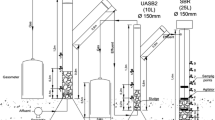Abstract
The production of spent coffee grounds (SCG) is steadily increasing, and its proper treatment has become an increasingly challenging task. This study explored the potential use of alkaline bottle-washing wastewater (BWW) from a soju (a Korean hard liquor) manufacturer as an alternative pretreatment agent to enhance the biodegradability and thus the biomethanation of SCG through anaerobic digestion. Thermo-alkaline pretreatment with BWW was effective in increasing the soluble organic fraction of SCG (i.e., improved bioavailability) at all temperatures tested (23–70 °C). The disintegration degree of the particulate organic matter in SCG ranged from 8.6 to 13.1% and increased with increasing pretreatment temperature. The 30-day methane yield (per g chemical oxygen demand (COD) of SCG fed) was significantly higher for the BWW-pretreated SCG (342.4–361.2 mL/g COD) than for the raw SCG (284.7 mL/g COD) and even for the NaOH-pretreated SCG (at the same pH as BWW, pH 12.3) tested for comparison (299.7–320.9 mL/g COD). This significant increase in methane production can be attributed to the presence of readily biodegradable ethanol derived from waste soju in BWW and the alkaline solubilization of SCG. Our results suggest a straightforward way to manage SCG and BWW together in a sustainable and economical manner.

Graphical abstract


Similar content being viewed by others
References
Arulrajah A, Maghoolpilehrood F, Disfani MM, Horpibulsuk S (2014) Spent coffee grounds as a non-structural embankment fill material: engineering and environmental considerations. J Cleaner Prod 72:181–186
Kim D, Kim J, Lee C (2018) Effect of mild-temperature thermo-alkaline pretreatment on the solubilization and anaerobic digestion of spent coffee grounds. Energies 11(4):865
Kim D, Kim H, Kim J, Lee C (2019) Co-feeding spent coffee grounds in anaerobic food waste digesters: effects of co-substrate and stabilization strategy. Bioresour Technol 288:121594. https://doi.org/10.1016/j.biortech.2019.121594
Kim J, Baek G, Kim J, Lee C (2019) Energy production from different organic wastes by anaerobic co-digestion: maximizing methane yield versus maximizing synergistic effect. Renew Energy 136:683–690
Mussatto SI, Machado EM, Martins S, Teixeira JA (2011) Production, composition, and application of coffee and its industrial residues. Food Bioprocess Technol 4(5):661–672
Lane A (1983) Anaerobic digestion of spent coffee grounds. Biomass 3(4):247–268
Dinsdale RM, Hawkes FR, Hawkes DL (1997) Comparison of mesophilic and thermophilic upflow anaerobic sludge blanket reactors treating instant coffee production wastewater. Water Res 31(1):163–169
Dinsdale RM, Hawkes FR, Hawkes DL (1996) The mesophilic and thermophilic anaerobic digestion of coffee waste containing coffee grounds. Water Res 30(2):371–377
Amin FR, Khalid H, Zhang H, u Rahman S, Zhang R, Liu G, Chen C (2017) Pretreatment methods of lignocellulosic biomass for anaerobic digestion. AMB Express 7(1):72
Machineni L (2020) Lignocellulosic biofuel production: review of alternatives. Biomass Convers Biorefin 10(3):779–791. https://doi.org/10.1007/s13399-019-00445-x
Milagres AMF, Carvalho W, Ferraz A (2011) Topochemistry, porosity and chemical composition affecting enzymatic hydrolysis of lignocellulosic materials. In: Buckeridge M, Goldman G (eds) Routes to cellulosic ethanol. Springer, New York. https://doi.org/10.1007/978-0-387-92740-4_5
Gundupalli MP, Kajiura H, Ishimizu T, Bhattacharyya D (2020) Alkaline hydrolysis of coconut pith: process optimization, enzymatic saccharification, and nitrobenzene oxidation of Kraft lignin. Biomass Convers Biorefin. https://doi.org/10.1007/s13399-020-00890-z
APHA-AWWA-WEF (2005) Standard methods for the examination of water and wastewater. American Public Health Association (APHA), Washington
Baek G, Kim J, Kim J, Lee C (2020) Individual and combined effects of magnetite addition and external voltage application on anaerobic digestion of dairy wastewater. Bioresour Technol 297:122443. https://doi.org/10.1016/j.biortech.2019.122443
Ait Hsine E, Benhammou A, Pons M (2005) Water resources management in soft drink industry-water use and wastewater generation. Environ Technol 26(12):1309–1316
Kim JS, Lee Y, Kim TH (2016) A review on alkaline pretreatment technology for bioconversion of lignocellulosic biomass. Bioresour Technol 199:42–48
Fountoulakis M, Petousi I, Manios T (2010) Co-digestion of sewage sludge with glycerol to boost biogas production. Waste Manag 30(10):1849–1853
Cheong D-Y, Harvey JT, Kim J, Lee C (2019) Improving biomethanation of chicken manure by co-digestion with ethanol plant effluent. Int J Environ Res Public Health 16(24):5023
Girotto F, Lavagnolo MC, Pivato A (2018) Spent coffee grounds alkaline pre-treatment as biorefinery option to enhance their anaerobic digestion yield. Waste Biomass Valorization 9(12):2565–2570. https://doi.org/10.1007/s12649-017-0033-8
Battista F, Fino D, Mancini G (2016) Optimization of biogas production from coffee production waste. Bioresour Technol 200:884–890. https://doi.org/10.1016/j.biortech.2015.11.020
Carrere H, Rafrafi Y, Battimelli A, Torrijos M, Delgenes JP, Motte C (2012) Improving methane production during the codigestion of waste-activated sludge and fatty wastewater: impact of thermo-alkaline pretreatment on batch and semi-continuous processes. Chem Eng J 210:404–409. https://doi.org/10.1016/j.cej.2012.09.005
Monlau F, Barakat A, Steyer JP, Carrere H (2012) Comparison of seven types of thermo-chemical pretreatments on the structural features and anaerobic digestion of sunflower stalks. Bioresour Technol 120:241–247. https://doi.org/10.1016/j.biortech.2012.06.040
Pellera F-M, Santori S, Pomi R, Polettini A, Gidarakos E (2016) Effect of alkaline pretreatment on anaerobic digestion of olive mill solid waste. Waste Manag 58:160–168. https://doi.org/10.1016/j.wasman.2016.08.008
Feng L, Yang L, Zhang L, Chen H, Chen J (2013) Improved methane production from waste activated sludge with low organic content by alkaline pretreatment at pH 10. Water Sci Technol 68(7):1591–1598
Funding
This research was supported by a grant from the National Research Foundation of Korea (NRF-2020R1A2C2004368) and by a grant from the Korea Institute of Energy Technology Evaluation and Planning through “Human Resources Program in Energy Technology” (No. 20164030201010/No. 20184030202250).
Author information
Authors and Affiliations
Corresponding author
Additional information
Publisher’s Note
Springer Nature remains neutral with regard to jurisdictional claims in published maps and institutional affiliations.
Rights and permissions
About this article
Cite this article
Kim, D., Choi, H. & Lee, C. Pretreatment of spent coffee grounds with alkaline soju bottle-washing wastewater for enhanced biomethanation. Biomass Conv. Bioref. 12, 803–808 (2022). https://doi.org/10.1007/s13399-020-01171-5
Received:
Revised:
Accepted:
Published:
Issue Date:
DOI: https://doi.org/10.1007/s13399-020-01171-5




